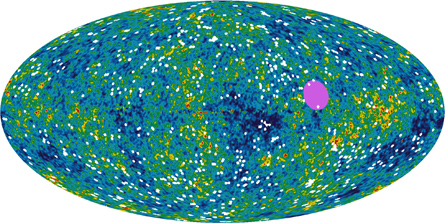Galaxies on the go
Millions of stars are mysteriously racing toward one point in the sky
By Susan Gaidos
 |
|
Galaxy clusters (white spots) are shown on a map of the cosmic microwave background, or CMB. The clusters appear to move, on average, in one direction (toward the purple spot).
|
| NASA, WMAP, Kashlinsky et al. |
Scientists have a mystery of cosmic proportions on their hands. Recently astronomers noticed something strange. It seems that millions of stars are racing at high speeds toward a single spot in the sky.
Huge collections of stars, gas and dust are called galaxies. Some galaxies congregate into groups of hundreds or thousands, called galaxy clusters. These clusters can be observed by the X-rays they give off.
Scientists are excited about the racing clusters because the cause of their movement can’t be explained by any known means.
The discovery came about when scientists studied a group of 700 racing clusters. These clusters were carefully mapped in the early 1990s using data collected by an orbiting telescope. The telescope recorded X-rays created by electrons located in the hot core of a galaxy cluster.
The researchers then looked at the same 700 clusters on a map of what’s called the cosmic microwave background, or CMB. It is radiation, a form of energy, leftover from the Big Bang. Scientists believe that the Big Bang marks the beginning of the universe, billions of years ago. The CMB provides a picture of how the early universe looked soon after the Big Bang.
By comparing information from the CMB to the map of galaxy clusters, scientists could measure the movement of the clusters. This is possible because a cluster’s movement causes a change in how bright the CMB appears.
As a galaxy cluster moves across the sky, the electrons from its hot core interact with radiation from the CMB. This interaction creates a change in the radiation’s frequency, or how often an event occurs in a certain amount of time. Scientists can then measure the frequencies to detect movement.
As a galaxy cluster moves toward Earth, the radiation frequency goes up. As a cluster moves away from Earth, the frequency goes down. This shift in the frequencies creates an effect similar to the Doppler effect.
The Doppler effect is commonly used to measure the speed of moving objects, such as cars. Scientists can use this method to measure the speed and direction of moving galaxies by looking at changes in the radiation frequencies.
What the scientists found surprised them. Though the frequency shifts were small, the clusters were moving across the sky at a high speed — about 1,000 kilometers per second. Even more surprising, the clusters were all moving in the same direction toward a single point in the sky.
Researchers don’t know what’s pulling this matter across the sky, but they are calling the source “dark flow.”
Whatever it is, scientists say the source likely lies outside the visible universe. That means it can’t be detected by ordinary means, such as telescopes.
One thing is certain. Dark flow has shown that we don’t understand everything we see in the universe and that there are still discoveries to be made.







